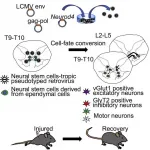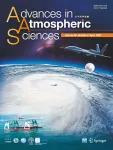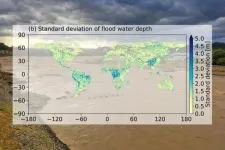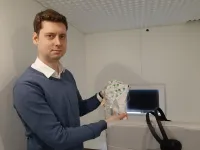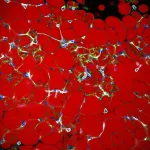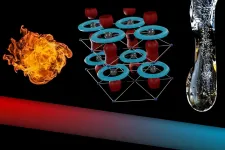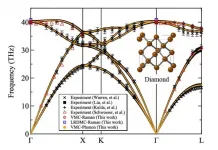New study sews doubt about the composition of 70 percent of our universe
Researchers the world over have long believed that 70 percent of the universe is composed of dark energy, a substance that makes it possible for the universe to expand at an ever-increasing rate. But in a new study, University of Copenhagen researchers te
2021-03-31
(Press-News.org) Until now, researchers have believed that dark energy accounted for nearly 70 percent of the ever-accelerating, expanding universe.
For many years, this mechanism has been associated with the so-called cosmological constant, developed by Einstein in 1917, that refers to an unknown repellant cosmic power.
But because the cosmological constant--known as dark energy--cannot be measured directly, numerous researchers, including Einstein, have doubted its existence--without being able to suggest a viable alternative.
Until now. In a new study by researchers at the University of Copenhagen, a model was tested that replaces dark energy with a dark matter in the form of magnetic forces.
"If what we discovered is accurate, it would upend our belief that what we thought made up 70 percent of the universe does not actually exist. We have removed dark energy from the equation and added in a few more properties for dark matter. This appears to have the same effect upon the universe's expansion as dark energy," explains Steen Harle Hansen, an associate professor at the Niels Bohr Institute's DARK Cosmology Centre.
The universe expands no differently without dark energy
The usual understanding of how the universe's energy is distributed is that it consists of five percent normal matter, 25 percent dark matter and 70 percent dark energy.
In the UCPH researchers' new model, the 25 percent share of dark matter is accorded special qualities that make the 70 percent of dark energy redundant.
"We don't know much about dark matter other than that it is a heavy and slow particle. But then we wondered--what if dark matter had some quality that was analogous to magnetism in it? We know that as normal particles move around, they create magnetism. And, magnets attract or repel other magnets--so what if that's what's going on in the universe? That this constant expansion of dark matter is occurring thanks to some sort of magnetic force?" asks Steen Hansen.
Computer model tests dark matter with a type of magnetic energy
Hansen's question served as the foundation for the new computer model, where researchers included everything that they know about the universe--including gravity, the speed of the universe's expansion and X, the unknown force that expands the universe.
"We developed a model that worked from the assumption that dark matter particles have a type of magnetic force and investigated what effect this force would have on the universe. It turns out that it would have exactly the same effect on the speed of the university's expansion as we know from dark energy," explains Steen Hansen.
However, there remains much about this mechanism that has yet to be understood by the researchers.
And it all needs to be checked in better models that take more factors into consideration. As Hansen puts it:
"Honestly, our discovery may just be a coincidence. But if it isn't, it is truly incredible. It would change our understanding of the universe's composition and why it is expanding. As far as our current knowledge, our ideas about dark matter with a type of magnetic force and the idea about dark energy are equally wild. Only more detailed observations will determine which of these models is the more realistic. So, it will be incredibly exciting to retest our result.
INFORMATION:
ELSE PRESS RELEASES FROM THIS DATE:
2021-03-31
Nagoya University researchers have identified a gene that plays a crucial role in regenerating neurons of African clawed frog tadpoles, which has an unusually high capacity for nerve regeneration. Their study, recently published in the journal iScience, showed that introducing the gene into mice with spinal cord injury (SCI) led to a partial recovery of their lost motor functions. These findings could contribute to the development of a new therapy for SCI, which often causes a person to experience permanent and severe physical and neurological disabilities.
Repairing spinal cord injuries in humans and other mammals is difficult, partly because ...
2021-03-31
Cancer patients generally have a higher thrombotic risk than the population at large. This risk is influenced on the one hand by patient-specific factors and the cancer itself and, on the other, by the cancer treatment, that is to say surgery, radiotherapy, or specific chemotherapeutics, which can increase the risk.
In the last few years, immune checkpoint inhibitors have increasingly been used to treat many different types of cancer. By activating the immune system against the tumour, these drugs improve the prognosis for patients with malignant melanoma, ...
2021-03-31
Tropical cyclones -- known as typhoons in the Pacific and as hurricanes in the Atlantic -- are fierce, complex storm systems that cause loss of human life and billions of dollars in damage every year. For decades, scientists have studied each storm, striving to understand the system yet unable to fully measure every intricate variable. Now, the convergence of new observational tools and the launch of an inclusive database may elucidate the innerworkings of tropical cyclones in the Western North Pacific and South China Sea.
Three papers were published in the latest issue of Advances in Atmospheric Science. One paper, led by the Chinese Meteorological Administration (CMA), focuses on a new tropical cyclone database, and the other two, led by The Petrel Meteorological ...
2021-03-31
Tokyo, Japan - A research team from the Institute of Industrial Science, The University of Tokyo has conducted a detailed analysis of the uncertainties associated with flood risk modeling at the global scale. They found large uncertainties were mainly associated with runoff data. Flood magnitude is large in wet regions, but uncertainties in flood depth is larger in dry and mountainous regions affected by rare, extreme floods. The results of the study can be used to identify the key areas for improvement in hydrological modeling and improve future predictions of flood risk.
Assessment of the risk of rare and extreme floods is essential ...
2021-03-31
A team of Nanyang Technological University, Singapore (NTU Singapore) researchers has designed a 'smart' device to harvest daylight and relay it to underground spaces, reducing the need to draw on traditional energy sources for lighting.
In Singapore, authorities are looking at the feasibility of digging deeper underground to create new space for infrastructure, storage, and utilities. Demand for round-the-clock underground lighting is therefore expected to rise in the future.
To develop a daylight harvesting device that can sustainably meet this need, the NTU team ...
2021-03-31
Japan is a country known for its continuous quality improvement (KAIZEN) in manufacturing. Now doctors are bringing this philosophy to the medical field. In pediatric intensive care units (PICU), quality improvement (QI) is needed to ensure complex medical care is provided to critically ill patients in a timely manner.
A research group led by Associate Professor Etsuko Nakagami-Yamaguchi and Graduate Student Yu Inata of the Department of Medical Quality and Safety Science, Osaka City University Graduate School of Medicine, set out to understand and assess the literature describing quality improvement in PICUs.
"Although ...
2021-03-31
Researchers from University of Tübingen (Tübingen, Germany) and Ural Federal University (Ekaterinburg, Russia) have developed and experimentally tested new method to understand how the brain builds associations between previously unrelated words. The findings are published in Journal of Neurolinguistics.
The scientists conducted used electroencephalography to measure how the brain responds to the incongruent sentence endings. So, the brain responses to the last word in the phrase "I like my coffee with cream and sugar" have much smaller magnitude as compared to the phrase "I like my coffee with cream and socks". The brain reacts in a similar way to words ...
2021-03-31
The protein Asc-1 regulates whether fat-burning beige or fat-storing white adipocytes are formed, which can have an impact on the development of metabolic diseases. This is shown by a current study of the Helmholtz Zentrum München and the German Center for Diabetes Research (DZD). The results open up new approaches to prevent the development of metabolic diseases. The study has now been published in Nature Communications.
Not all fat is the same: there is white, brown and beige adipose tissue *. While white fat cells serve as energy stores, excess energy is burned in brown and beige fat tissue. Too much white fat is considered unhealthy. If the white adipose ...
2021-03-31
A thermos bottle has the task of preserving the temperature - but sometimes you want to achieve the opposite: Computer chips generate heat that must be dissipated as quickly as possible so that the chip is not destroyed. This requires special materials with particularly good heat conduction properties.
In collaboration with groups from China and the United States, a research team from TU Wien therefore set out to find the optimal heat conductor. They finally found what they were looking for in a very specific form of tantalum nitride - no other known metallic material has a higher thermal conductivity. In order to be able to identify this record-breaking material, they first had to analyse which processes play a role in heat conduction in such materials at the ...
2021-03-31
Ishikawa, Japan - The focus and ultimate goal of computational research in materials science and condensed matter physics is to solve the Schrödinger equation--the fundamental equation describing how electrons behave inside matter--exactly (without resorting to simplifying approximations). While experiments can certainly provide interesting insights into a material's properties, it is often computations that reveal the underlying physical mechanism. However, computations need not rely on experimental data and can, in fact, be performed independently, an approach known as "ab initio calculations". The density functional theory (DFT) is a popular example of such an approach.
For most material ...
LAST 30 PRESS RELEASES:
[Press-News.org] New study sews doubt about the composition of 70 percent of our universe
Researchers the world over have long believed that 70 percent of the universe is composed of dark energy, a substance that makes it possible for the universe to expand at an ever-increasing rate. But in a new study, University of Copenhagen researchers te
